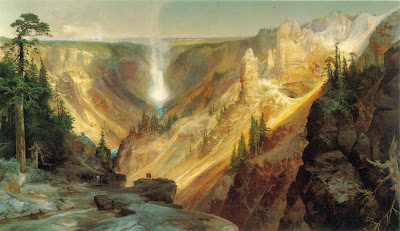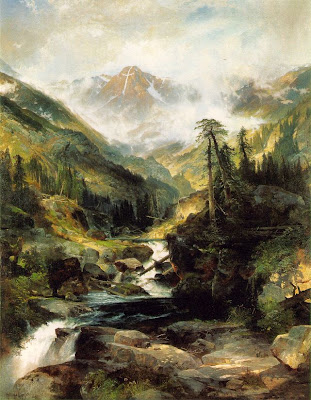Commonly known as the West's greatest landscape painter, Thomas Moran was one of the major romantic painters and printmakers of the 19th century. In addition to being a great artist, he was also an explorer and traveler, and was best known for his first paintings of Yellowstone country in what later became known as America's first national wilderness park. In 1871, Moran was determined to accompany the expedition to survey the Yellowstone valley led by Dr. Ferdinand V. Hayden and was accepted as a welcome but unofficial member. It was during this expedition where Moran visualized the wonders of Yellowstone and made his drawings of them even more impressive as he rendered them with marvelous colors.

The Grand Canyon of Yellowstone, 1893. Oil on Canvas, 96 1/2 x 168 3/8 in.
National Museum of American Art, Smithsonian Institution, Gift of George D. Pratt, 1928.7.1.
The oil canvas above is Moran's masterpiece from his Yellowstone expedition titled The Grand Canyon of the Yellowstone, which he painted in 1893. This particular scene is said to be Moran's favorite amongst all the other sights he saw in the Yellowstone valley. Moran took the time to sketch the canyon from numerous angles while studying the geology of the area and the way the light played on the rocks to capture the lively colors of the gorge. What makes this interesting is the fact that he only made sketches of the canyon during his travels and then carried his sketchbook back to a studio in Newark, NJ, where he completed the painting by memory. Apparently his memory had retained all the color and drama of the setting, and he finished the piece in just two months.
Forrest of Fontainebleau, 1867. 9 3/4 x 13 1/3 in. (Gilcrease Insitute, 1376.743)
The sketch above is Moran's Forrest of Fontainebleau, which is located about thirty miles from Paris, France. In this piece, Moran applied while chalk over some of the pencil to simulate dappled sunlight on rocks, trees, and earth. He also used this technique to form clouds. Although these white highlights were very subtle, they do give off a nice sunlight effect. In a similar piece called Fontainebleau, Moran applied the chalk and then used a moist brush to soften the hard edges.
Mountain of the Holy Cross, 1875. Oil on Canvas. Autry Museum of Western Heritage, Los Angeles.
The Oil Canvas above is known as Moran's third great western lanscape canvases, which he drew on his third trip out west. This mountain is hidden deep within the Colorado Rocky Mountains and it was difficult for Moran to reach. But once found, he discovered that there was only one good vantage point from which to view the snow-engorged, cross-like snow crevasse at the mountain's peak. It is also interesting how Moran decided to freely invent the waterfall in the foreground of the canvas in order to capture the true impression of the scene.
References:
Moran, Thomas, 1837-1926. Thomas Moran, the Field Sketches, 1856-1923. Ed. Anne Morand. Norman: University of Oklahoma Press, 1996. Web.
Morand, Anne, 1951-. Splendors of the American West : Thomas Moran's Art of the Grand Canyon and Yellowstone : Paintings, Watercolors, Drawings, and Photographs from the Thomas Gilcrease Institute of American History and Art. Eds. Birmingham Museum of Art (Birmingham,Ala.), et al. Birmingham, Ala.; Seattle: Birmingham Museum of Art; Distributed by the University of Washington Press, 1990. Web.
Wilkins, Thurman. Thomas Moran: Artist of the Mountains. Norman: University of Oklahoma Press, 1969, 1966. Web.


No comments:
Post a Comment